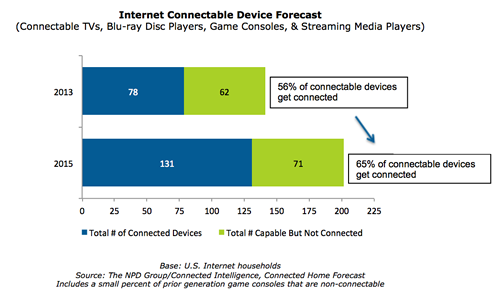PORT WASHINGTON, NEW YORK – JULY 21, 2014 – By 2017 there will be 204 million connected TV devices linked to the Internet and able to deliver apps to viewers, more than double the projected number of U.S. Internet households. These devices include video game consoles, streaming media players, Blu-ray Disc players, and TVs. According to the latest NPD Connected Intelligence Connected Home Forecast, ownership of connected TV devices is expected to grow 100 percent by 2017.
Two driving forces in the market are pushing the adoption and use of connected TV devices; streaming media players and the TVs itself. These devices are expected to represent the majority of the growth in installed and Internet connected units over the next three years.
As more of these connected devices are installed, the rate at which consumers connect Internet capable TV devices is expected to increase from 60 percent in 2014 to 76 percent of installed units by 2017. The increased connectivity will be bolstered by hardware upgrades that prompt consumers to connect, increased app programming from TV networks, and improvements to user interfaces.
“The evolution of hardware and digital content distribution is constantly changing the TV viewing experience,” said John Buffone, executive director, NPD Connected Intelligence. “Over the coming years, the consumer’s preferred device for apps on TV will be shaped by the next generation of video game consoles, Smart TVs, and a new wave of streaming media players.”

By 2018 the connected TV device market will begin to reach saturation. The average U.S. home has three TVs, and by 2018 a majority of homes that want apps on their TV will have a connected device on their primary and secondary displays. A large portion of the connected TV device market will move from being for first-time connected TV households to consumers entering a device upgrade cycle.
“Due to the rapid growth of connected TV devices, now is the time to establish consumer loyalty,” said Buffone. “Millions of viewers are trying new devices and apps, deciding which, if any, will become an indispensable part of their TV time.”
Connected Home Forecast Methodology
The Connected Home forecast is based on NPDs quarterly Connected Home surveys conducted among more than 5,000 U.S. consumers, age 18 and older. Using the NPD Consumer and Retail Tracking services, historical installed base reporting is mapped to sales trends for each device category. Coupled with internet connection rates, these data are used to project a view of the connectable and connected device installed base.
About Connected Intelligence
Connected Intelligence provides competitive intelligence and insight on the rapidly evolving consumer’s connected environment. The service focuses on the three core components of the connected market: the device, the broadband access that provides the connectivity and the content that drives consumer behavior. These three pillars of the connected ecosystem are analyzed through a comprehensive review of what is available, adopted, and consumed by the customer, as well as reviewing how the market will evolve over time and what the various vendors can do to best position themselves in this evolving market. For more information: http://www.connected-intelligence.com. Follow Connected Intelligence on Twitter: @npdci.
About The NPD Group, Inc.
The NPD Group provides global information and advisory services to drive better business decisions. By combining unique data assets with unmatched industry expertise, we help our clients track their markets, understand consumers, and drive profitable growth. Sectors covered include automotive, beauty, consumer electronics, entertainment, fashion, food / foodservice, home, luxury, mobile, office supplies, sports, technology, toys, and video games. For more information, visit www.npd.com and npdgroupblog.com. Follow us on Twitter: @npdtech and @npdgroup.
CONTACT:
Sarah Bogaty
+1 516 625 2357
sarah.bogaty@npd.com










